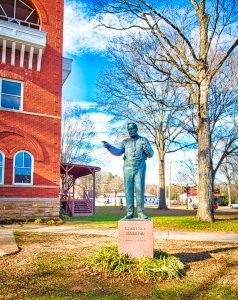As I drove halfway across the country for the holidays, I took backroads. You all know how Stu and I love backroads! But traffic was heavy and the two-lane highway I was traveling seemed to always have 10 vehicles in front of me due to solid yellow lines on the roadway.
Frustration set in. I had promised to be at my daughter’s on a certain day. “Why did I take THIS road?” I will NEVER get there! You know the feeling.
Backroads shelter surprises and I should have known I would see some in Tennessee. All of a sudden, a sign appeared that said, “Scopes Trial Museum.” Whaaat? THE Scopes Trial? Nah, couldn’t be THAT trial. It was a rural area with small towns, so I thought, “Well, the trial must’ve taken place in this region of Tennessee.”
I was so WRONG! I entered Dayton, Tennessee, came to the first stoplight where GPS told me to turn right, and the Rhea County, Tennessee Courthouse stood on the corner! The historic Scopes Trial (Scopes Monkey Trial) took place in that courthouse in 1925! The trial pitched the science of evolution against perceived teachings in the Bible. The evolution argument continues to this day.

Of course, I HAD to stop!
THE HISTORIC SCOPES TRIAL
The State of Tennessee, in 1925, brought charges against a substitute teacher, John Scopes, for teaching evolution to his students. John Scopes admitted to teaching evolution. The ACLU at the time was anxious to bring a case to challenge the Tennessee law prohibiting the teaching of evolution. They would finance a test case so a deal was struck with Scopes. Scopes was charged with breaking state law.

Two reknown orators of the day, William Jennings Bryan and Clarence Darrow, took on the case. Bryan volunteered to present for the prosecution and Darrow for the defense.
William Jennings Bryan had been a three-time presidential candidate and was an avid anti-evolution activist.

Originally, the author, H.G. Wells, was asked to defend Scopes but he turned down the case. Instead, Clarence Darrow, the famous attorney, agreed to defend Scopes after hearing that Bryan was going to prosecute.

The trial became a media circus with merchandise and newspaper cartoons associated with the clash between science and religion sweeping the country. There was so much interest in the trial that six blocks of Dayton’s main road was altered into a pedestrian mall, a speakers’ platform was built on the grounds of the courthouse and a tourist camp was established.*
The latest technology, including telegraph and telephone lines, movie newsreel platforms and radio microphones were brought into the courtroom in anticipation of the proceedings. WGN Radio broadcast the trial live at a cost of more than $1,000 a day just for the telephone lines and was the very first broadcast of its kind in the U.S.*

The weather was so hot in July of 1925, that some of the trial proceedings took place outdoors. Bryan not only served as the prosecutor but also as a witness on the writings of the Bible.

The trial lasted one week and a jury found John Scopes guilty.
Scopes was fined $100 which both Bryan and the ACLU offered to pay.
The award-winning movie, Inherit the Wind, starring Spencer Tracy and Fredric March was released in 1960 and was based on the famous Scopes Trial.
Although the Scopes Trial Museum was closed, I felt honored to be visiting the site of amazing American history!
Never underestimate what you will find on America’s backroads!